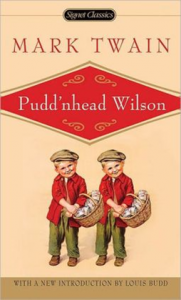Tom Driscoll (Valet de Chambre)
Character: Tom Driscoll (Valet de Chambre)
Source Text: Mark Twain, The Tragedy of Pudd’nhead Wilson (1894)
Entry Author: Adam Kelley
The character known throughout the text of Puddn’head Wilson as Tom Driscoll, a white southern aristocrat, was actually born Valet de Chambre, a mixed race child born a slave, but was switched at birth by his slave mother Roxana, “Roxy”. Chambers, hereafter referred to as Tom, ‘passes’ as the son of Judge Driscoll, descended from the “First Families” of aristocratic “Old Virginia” lineage. Tom’s real identity is later revealed using forensic evidence that proves his birth, but his appearance and success as an imposter challenge 19th century notions of racial identity. Tom, is born a ‘black’ slave by the ‘one drop’ rule, lives half his life as free white man of a locally respected family, and is ultimately revealed and sold back into slavery. The irony of his fate draws out the arbitrary nature of socially and legally constructed racial identity.
The imposter Tom’s race is known through his mixed race mother Roxy. The narrator describes her as “white as anybody, but the one sixteenth of her which was black out voted the other fifteen parts and made her a negro” (Twain 9). Twain’s matter-of-fact tone parodies the absurd nature of 19th century legal definitions of race. He presses this point farther when he describes of Roxy’s son that “he was thirty-one parts white, and he, too, was a slave, and by a fiction of law and custom a negro” (9). Both Roxy’s and her child’s racial status is defined legally in terms of the “one drop rule” that defines them as slaves by descent.
Physically, Roxy’s son ‘Chambers’ and the child Tom Driscoll appear identical. Twain describes of Chambers that “he had blue eyes and flaxen curls, like his white comrade” (9). The only discernable marker between the two infants is their clothing: the Driscoll child dressed in the finest garb and ornament, and Chambers stuffed into a “course” shirt that “barely reached his knees” (9). This further links the racial identity of the children to social cues imbedded in status symbols, and not in anything inherent in the children themselves.
Later in life the imposter Tom is informed by his mother that he was switched at birth and this has a devastating effect on his sense of self. After the revelation he wakes in the morning to exclaim the infamous lines “‘A nigger!—I am a nigger!—oh, I wish I was dead!’” (48). Profoundly disturbed by the news of his origin, Tom’s personality is shattered and he immediately begins to internalize the racial stereotypes he once cast on others. He feels “the curse of Ham upon him” (49) and “the ‘nigger’ in him was ashamed to sit at the white folks table” (49). He becomes deeply aware of his vulnerability under the law, and lives his life in constant fear of being found out.
All of Tom’s social relationships become inverted: his mother, once his slave, now lords her secret knowledge of his identity over him, and his perception of his relationship to his Uncle and his community alters drastically from entitlement to suspicion. His drastic shift in mood draws out the effects of racial prejudice on the marginalized of society. Tom is unwittingly forced into the position of ‘passing’ as white, and grows up oblivious of his origin. But, once he learns his true origin, he immediately begins to question his own identity and alters his personality and behavior. Nevertheless, Tom is consistently a despicable character: callous, cruel, and manipulative, but his punishment of being “sold down the river” feels unjust even for such an unlikable person. Tom, although being guilty of multiple counts of theft and even a murder, is ultimately punished merely for being a fraction ‘negro’.

